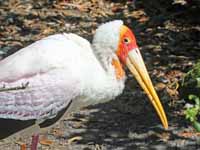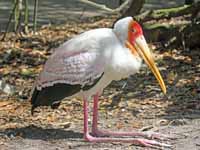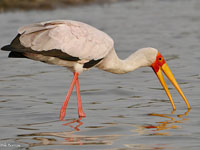The storks, which belong to the Ciconiidae family, are found worldwide in temperate or tropic climates. Those in temperate climates migrate to warmer places during the winter. They are large birds with especially long legs and bills. Even the smallest species is 70 cm (27 in) tall while the largest is over 150 cm (59 in) in height. Males larger than females.
Storks tend to use soaring, gliding flight, which conserves energy. They use thermals to soar to over 1200 meters (4000 ft), glide in the direction of travel, gaining elevation again with another thermal, etc. They gather into large flocks for migration. When in flight, almost all storks have their necks and legs extended giving them an elongated shape. The 3 species in genus Leptoptilos fly with the neck retracted like herons.
Storks are carnivorous, not a vegetarian among them. Most favor aquatic habitants where they can wade to hunt and eat, fish, small amphibians, reptiles, insect larvae and more. The marabou stork and the greater adjutant eat carrion and have bald vulture-like heads. The Abdim’s stork eats mainly locusts, caterpillars and other large insects; also reptiles, mice and more.
Some species are colonial breeds while other enjoy nesting in solitude. Most storks nests in trees; some on cliffs or buildings. The maguari stork’s nest is made of grass and reeds and constructed on the ground. That is the exception; stork nests are usually built with sticks then covered with twigs, vegetation, or mud.
Storks are nonvocal birds and usually silent. However, greetings are made upon nest arrival by rapidly opening and closing its beak so that a clattering sound is made. Some species have a pouch that amplifies this sound. The clattering greeting may be accompanied by accompanied by deep head bowing and neck stretching. Clattering sound can also be produced by the partners striking their bills together.
Habitat: Most of the species are wading birds implying they like the edges of ponds and lakes. Other wet areas they frequent for finding food: streams, rivers, marshes, swamps. flooded meadows. A few species prefer dry grassy meadows. Less typical habitats include dense temperate forests (European black stork), and rain forests (Storm’s stork).
Genus Anastomus
The openbills are large wading birds characterized by large bills, the mandibles of which do not meet except at the tip. The cutting edges of the mandible have a fine brush like structure that is thought to give them better grip on snails. This feature develops only in the adults. No agreement about why the mandibles are gapped; perhaps so more pressure can be applied at the tips. They nest colonially in trees.
Stork,_African Openbill also African Openbill Anastomus lamelligerus
Description: Dark plumage with glossy green, brown, and purple on the mantle, breast; large brown bill; grey eyes; black legs, feet; gap between the mandibles. Length 80 – 94 cm (31 – 37 in) , weight 1 – 1.3 kg (2.2 – 2.9 lb).
Identification: The only openbill stork in Africa. Only stork without white on body. Range: Sub-Saharan Afria.
Habitat and Behavior: Found shallow wetlands such as streams, lake edges, rice patties; also tidal mud flats. Eats mainly freshwater mussels and snails; also fish, frogs, insects. Nest colonially in trees. Nest made of sticks and reeds. Chalky-white eggs.
Subspecies:
A. l. lamelligerus – sub-Saharan Africa
A. l. madagascariensis – Madagascar
Conservtion Status: Least concern.
Image by: 1, 2) Dick Daniels - San Diego Zoo 3) Sandy
Cole - San Diego Zoo 4) Charlie WesterinenIdentification: The only openbill stork in Africa. Only stork without white on body. Range: Sub-Saharan Afria.
Habitat and Behavior: Found shallow wetlands such as streams, lake edges, rice patties; also tidal mud flats. Eats mainly freshwater mussels and snails; also fish, frogs, insects. Nest colonially in trees. Nest made of sticks and reeds. Chalky-white eggs.
Subspecies:
A. l. lamelligerus – sub-Saharan Africa
A. l. madagascariensis – Madagascar
Conservtion Status: Least concern.
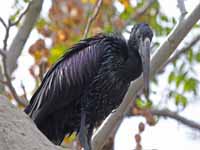

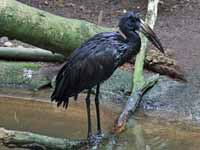
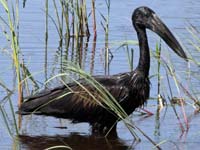
Stork,_Asian Openbill also Asian Openbill Anastomus oscitans
Description: Mainly grey plumage; gap between the mandibles. Breeding: glossy black wings, tail. Nonbreeding: white wings, tail. Juvenile: mainly greyish-brown plumage; brown mantle. Length 81 cm (32 in), height 68 cm (27 in); a relatively small stork.
Identification: The Asian openbill, oriental stork, and white stork look the same at a distance. The Asian openbill has gap between mandibles. Oriental Stork has blackish bill; White Stork has reddish bill.
Range: Indian subcontinent, Southeast Asia; rarely found at tidal flats.
Habitat and Behavior: Frequent inland wetlands such as marshes and irrigation canals. Rarely found at coast. Mainly eats snails, using bill tips to extract body. Nests colonially in trees. Parents share incubation.
Conservtion Status: Least concern.
Image by: 1, 2) Charlie Westerinen near Seim Reap Cambodia 3) JJ Harrison - ThailandIdentification: The Asian openbill, oriental stork, and white stork look the same at a distance. The Asian openbill has gap between mandibles. Oriental Stork has blackish bill; White Stork has reddish bill.
Range: Indian subcontinent, Southeast Asia; rarely found at tidal flats.
Habitat and Behavior: Frequent inland wetlands such as marshes and irrigation canals. Rarely found at coast. Mainly eats snails, using bill tips to extract body. Nests colonially in trees. Parents share incubation.
Conservtion Status: Least concern.
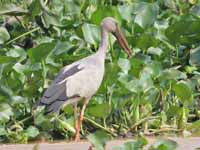

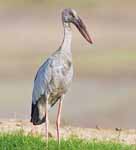
Genus Ciconia
These storks feed on frogs, insects, young birds, lizards and rodents. Does not nest in large colonies; some species nest individually while others may have up to 20 nests in a small colony. Many of these species loudly tap their partner’s bill while at the nest.
Stork,_Abdim's Ciconia abdimii
Description: Black upperparts, head, neck, upper-breast; white lower-breast, belly; grey legs, bill; red knees, feet. In breeding season it has red skin in front of eyes; blue skin near the bill. It is the smallest stork. Height 75-81 cm (30-32 in), weight 1160-1570 (2.6-3.5 lbs).
Identification: The Abdim’s stork and the black stork are the only African storks with dark upperparts, head, and neck. Abdim’s stork has grey bill, black stork has red bill.
Range: Central Africa to South Africa.
Habitat and Behavior: Found mainly in grasslands; also wetlands. Eats mainly locusts, caterpillars and other large insects; also amphibians, reptiles, mice. Nests in small colonies, up to 20 nests. Nests located mainly on trees or cliffs; also roofs.
Conservtion Status: Least concern.
Image by: 1) Christiaan Kooyman - Niger 2) Ian White -
Zambia
3) Dick Daniels - San Diego Zoo 4) Sandy Cole - Sylvan Heights 5) Dick - Sylvan HeightsIdentification: The Abdim’s stork and the black stork are the only African storks with dark upperparts, head, and neck. Abdim’s stork has grey bill, black stork has red bill.
Range: Central Africa to South Africa.
Habitat and Behavior: Found mainly in grasslands; also wetlands. Eats mainly locusts, caterpillars and other large insects; also amphibians, reptiles, mice. Nests in small colonies, up to 20 nests. Nests located mainly on trees or cliffs; also roofs.
Conservtion Status: Least concern.
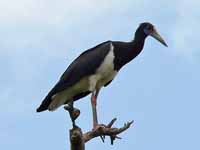
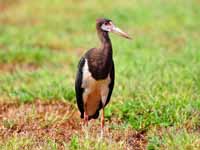

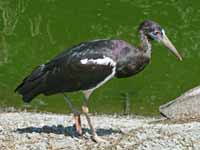
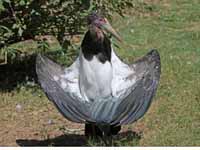
Stork,_Black Ciconia nigra
Description: Mainly black plumage; white lower-breast, belly, under-tail coverts; red bill, legs, skin around the eyes. Length 95 to 100 cm (37 to 39 in), wingspan 145 to 155 cm (57 to 61 in).
Identification: The Abdim’s stork and the black stork are the only African storks with dark upperparts, head, and neck. Abdim’s stork has grey bill, black stork has red bill. The black-necked stork and black stork only Asian / Australasian storks with both head and neck black. Black stork has red bill; black-necked stork has black bill.
Range: Europe, Asia, Africa, Australasia.
Habitat and Behavior: Found in woodlands as well as wetlands. Avoids people. Wades slowly in shallow water to find prey. Eats amphibians, small fish, insects; generally wading slowly in shallow water stalking its prey. European storks migrate to Sub-Saharan Africa; temperate Asian migrates to Indian subcontinent. Nests built in large trees in marshy wetlands. Not colonial nester.
Conservtion Status: Least concern.
Image by: 1) Imran_Shah - Pakistan 2) Sergey Pisarevskiy - Russia 3) Cristiano Crolle - Racconigi, Italy 4) JV Verde - Portugal Identification: The Abdim’s stork and the black stork are the only African storks with dark upperparts, head, and neck. Abdim’s stork has grey bill, black stork has red bill. The black-necked stork and black stork only Asian / Australasian storks with both head and neck black. Black stork has red bill; black-necked stork has black bill.
Range: Europe, Asia, Africa, Australasia.
Habitat and Behavior: Found in woodlands as well as wetlands. Avoids people. Wades slowly in shallow water to find prey. Eats amphibians, small fish, insects; generally wading slowly in shallow water stalking its prey. European storks migrate to Sub-Saharan Africa; temperate Asian migrates to Indian subcontinent. Nests built in large trees in marshy wetlands. Not colonial nester.
Conservtion Status: Least concern.
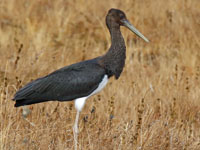

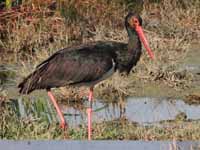
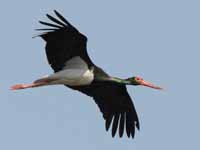 |
|Stork,_Maguari Ciconia maguari
Description: White body, neck; mostly black wings; forked blacked tail; bill upper part light grey, lower part dark maroon. Height 97–120 cm, wingspan 150–180 cm, weight 3800-4200g (8.4 – 9.3 lb).
Identification: The only storks in the Americas are: jabiru, maguari stork, wood stork. They are easily differentiated.
Range: South America.
Habitat and Behavior: Prefer shallow-water wetlands, marshes, mudflats, flooded fields. Eats a wide variety of prey: fish, frogs, earthworms, snakes, invertebrates, insect larvae, freshwater crabs, small mammals. Usually nests on ground in tall grass and reeds; sometimes nests in low trees. Usually nests in small colonies, up to 20 pairs. Sometimes nests individually.
Conservtion Status: Least concern.
Image by: 1, 2, 4, 5, 6)
Cláudio Timm - Rio Grande do Sul, Brazil 3) Cristiano Crolle - Esteros del Iberà, Argentina Identification: The only storks in the Americas are: jabiru, maguari stork, wood stork. They are easily differentiated.
Range: South America.
Habitat and Behavior: Prefer shallow-water wetlands, marshes, mudflats, flooded fields. Eats a wide variety of prey: fish, frogs, earthworms, snakes, invertebrates, insect larvae, freshwater crabs, small mammals. Usually nests on ground in tall grass and reeds; sometimes nests in low trees. Usually nests in small colonies, up to 20 pairs. Sometimes nests individually.
Conservtion Status: Least concern.
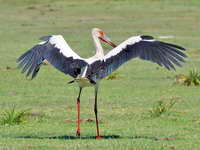
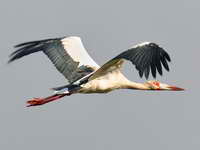
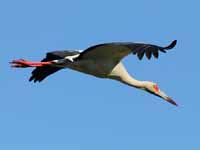



Stork,_Oriental Ciconia boyciana
Description: white plumage; black wings; red legs, skin around eyes; blackish bill. Height 110–115 cm (43-45 in), wingspan 195-200 cm (77-79 ft), weight 3.7–5.5 kg (8.2-12.1 lb).
Identification: The Asian openbill, oriental stork, and white stork look the same at a distance. The Asian openbill has gap between mandibles. Oriental Stork has blackish bill; White Stork has reddish bill.
Range: Eastern China, Japan, Manchuria, Korea, Siberia.
Habitat and Behavior: Appears in wetlands such as marshes, pond’s edges, coastal beaches. Eats fish, frogs, insects, small birds, reptiles; also rodents. Nests individually or in small colonies of less than 10 nests. Nests located mainly in trees; also on roofs.
s Endangered.
Image by: 1, 3) Hiyashi Haka 2) Spaceaero2 4) Blake Matheson - Yangtze BasinIdentification: The Asian openbill, oriental stork, and white stork look the same at a distance. The Asian openbill has gap between mandibles. Oriental Stork has blackish bill; White Stork has reddish bill.
Range: Eastern China, Japan, Manchuria, Korea, Siberia.
Habitat and Behavior: Appears in wetlands such as marshes, pond’s edges, coastal beaches. Eats fish, frogs, insects, small birds, reptiles; also rodents. Nests individually or in small colonies of less than 10 nests. Nests located mainly in trees; also on roofs.
s Endangered.
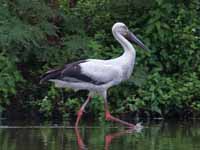
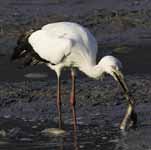
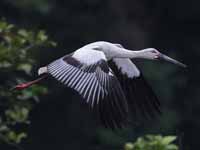
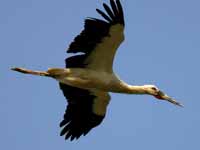
Stork,_Storm's Ciconia stormi
Description: Mainly black plumage; white neck; red bill, eyes, legs; orange bare facial skin. Height 75–91 cm (30 -36 in).
Identification: Storm’s stork and woolly stork have a dark body. Woolly does not have orange orbital skin and it does not have any black on neck.
Range: Indonesia, Malaysia, southern Thailand. Main population on Borneo.
Habitat and Behavior: Found in lowland dense tropical forests near sources of water. With help of thermals, soars to great heights. Nests, which are made of sticks and twigs, are 30 -50 cm (12 – 20 in) diameter and located high in trees. Not colonial breeder. Eats small fish, frogs, insect larvae; also worms.
Conservtion Status: Endangered.
Image by: 1) Nathan Rupert 2, 3 Sandy Cole - San Diego Zoo 4) Mark Lewis BenedictIdentification: Storm’s stork and woolly stork have a dark body. Woolly does not have orange orbital skin and it does not have any black on neck.
Range: Indonesia, Malaysia, southern Thailand. Main population on Borneo.
Habitat and Behavior: Found in lowland dense tropical forests near sources of water. With help of thermals, soars to great heights. Nests, which are made of sticks and twigs, are 30 -50 cm (12 – 20 in) diameter and located high in trees. Not colonial breeder. Eats small fish, frogs, insect larvae; also worms.
Conservtion Status: Endangered.
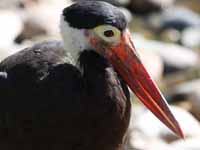

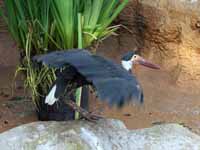
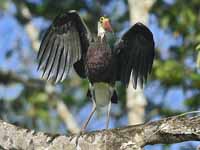
Stork,_White Ciconia ciconia
Description: Mainly white plumage; black wings skin around eyes; red legs, bill. Length 100–115 cm (39–45 in); height 100–125 cm (39–49 in), wingspan 155–215 cm (61–85 in), weight 2.3–4.5 kg (5.1–9.9 lb).
Identification: The Asian openbill, oriental stork, and white stork look the same at a distance. The Asian openbill has gap between mandibles. Oriental Stork has blackish bill; White Stork has reddish bill.
Range: Europe, Asia, Africa.
Habitat and Behavior: Prefers grassy meadows, farmland, shallow wetlands; avoids overgrown areas. Eats various prey: rodents, fish, crustaceans, insects, amphibians. Nests in haphazard colonies or individually. Nest large, built from sticks; located on trees, roofs, human created platforms. Eggs white. Enthusiastic bill-clattering; sound magnified by throat pouch. Migrates long distances. European migrants detour around Mediterranean because thermals do not form reliably over water.
Subspecies:
C. c. asiatica – Turkestan; winters to Iran and India
C. c. ciconia – Europe and w Asia: winters to tropical and South Africa
Conservtion Status: Least concern.
Image by: 1) Charlie Westerinen 2) Dick Daniels - South Africa 3) Sandy Cole - San Diego Zoo 4) Cristiano Crolle - Racconigi, Italy 5) Erik Lecaroubuier - France 6,7) JV Verde - Portugal 8) Video by Avibirds. More vidoesIdentification: The Asian openbill, oriental stork, and white stork look the same at a distance. The Asian openbill has gap between mandibles. Oriental Stork has blackish bill; White Stork has reddish bill.
Range: Europe, Asia, Africa.
Habitat and Behavior: Prefers grassy meadows, farmland, shallow wetlands; avoids overgrown areas. Eats various prey: rodents, fish, crustaceans, insects, amphibians. Nests in haphazard colonies or individually. Nest large, built from sticks; located on trees, roofs, human created platforms. Eggs white. Enthusiastic bill-clattering; sound magnified by throat pouch. Migrates long distances. European migrants detour around Mediterranean because thermals do not form reliably over water.
Subspecies:
C. c. asiatica – Turkestan; winters to Iran and India
C. c. ciconia – Europe and w Asia: winters to tropical and South Africa
Conservtion Status: Least concern.
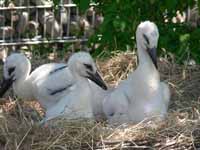
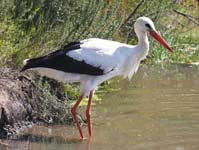

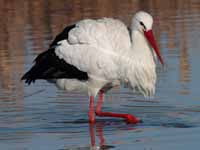
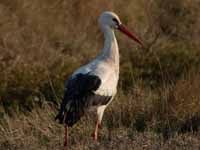
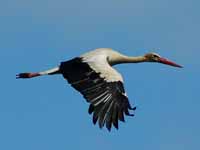
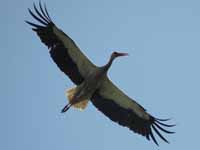
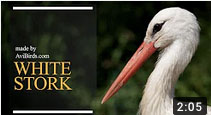
Stork,_Woolly also Woolly-necked Stork Ciconia episcopus Found: Asia, Africa
Description: Glossy blackish-green plumage; black crown of variable size; white neck, lower-belly, tail; blackish bill sometimes with red; red legs, eyes. Height 75–92 cm.
Identification: Storm’s stork and woolly stork have a dark body. Woolly does not have orange orbital skin and it does not have any black on neck.
Range: tropical Asia, Africa.
Habitat and Behavior: Found at freshwater wetlands including ponds, irrigation canals; also fields. Eats amphibians, reptiles, insects; also fish, frogs, snakes. Attracted to grassland fires which disturb insects. Breeds in pairs or small groups. Nests in trees or cliffs. Have been seen soaring close to 4000 meters (13,000 ft).
Subspecies:
C. e. episcopus – India to Indochina, n Malay Peninsula and Philippines
C. e. microscelis – Tropical Africa C. e. neglecta – Java and Wallacea
Conservtion Status: Near threatened.
Image by: 1, 2) Dick Daniels - South Africa, 3) Kaippally 4) Ian White - South Africa 5) Dave Curtis - Kenya 6 Lip Kee - Botswana Identification: Storm’s stork and woolly stork have a dark body. Woolly does not have orange orbital skin and it does not have any black on neck.
Range: tropical Asia, Africa.
Habitat and Behavior: Found at freshwater wetlands including ponds, irrigation canals; also fields. Eats amphibians, reptiles, insects; also fish, frogs, snakes. Attracted to grassland fires which disturb insects. Breeds in pairs or small groups. Nests in trees or cliffs. Have been seen soaring close to 4000 meters (13,000 ft).
Subspecies:
C. e. episcopus – India to Indochina, n Malay Peninsula and Philippines
C. e. microscelis – Tropical Africa C. e. neglecta – Java and Wallacea
Conservtion Status: Near threatened.
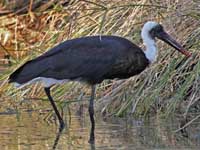
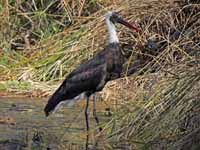
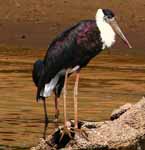
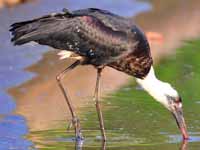
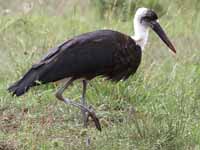
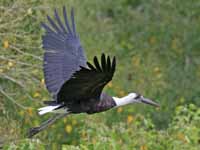
Genus Ephippiorhynchus
Two species of very large storks with black necks, both with impressive bills. The males have brown eyes, females yellow or golden. They do not nest colonially.
Stork,_Black-necked Ephippiorhynchus asiaticus
Description: Black neck, head, bill, secondary flight feathers, tail; white back, belly; red legs. Male has brown iris; female has yellow iris. Height 130 cm (51 in), wingspan 200 cm (79 in).
Identification: The black-necked stork and black stork only Asian / Australasian storks with both head and neck black. Black stork has red bill; black-necked stork has black bill.
Range: southern Asia, Australasia. Australia has largest population.
Habitat and Behavior: Occur mainly near freshwater wetlands; occasionally at coastal areas. Nests create in trees and made of sticks, branches lined with vegetation and sometimes mud. An opportunistic eater: fish, reptiles, crustaceans, birds as large as coots.
Subspecies:
E. a. asiaticus - Indian subcontinent and SE Asia
E. a. australis – N and e Australia and s New Guinea
Conservtion Status: Near threatened due to habitat loss.
Image by: 1) Arthur
Chapman - Australia 2) David Cook - Australia
3) JM Garg - India
4) Ralph Green - Australia 5) Dick - Australia
Identification: The black-necked stork and black stork only Asian / Australasian storks with both head and neck black. Black stork has red bill; black-necked stork has black bill.
Range: southern Asia, Australasia. Australia has largest population.
Habitat and Behavior: Occur mainly near freshwater wetlands; occasionally at coastal areas. Nests create in trees and made of sticks, branches lined with vegetation and sometimes mud. An opportunistic eater: fish, reptiles, crustaceans, birds as large as coots.
Subspecies:
E. a. asiaticus - Indian subcontinent and SE Asia
E. a. australis – N and e Australia and s New Guinea
Conservtion Status: Near threatened due to habitat loss.
1) Juvenile 2) Pair 3) Female 4) Male
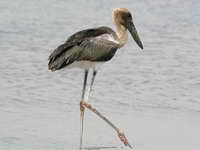
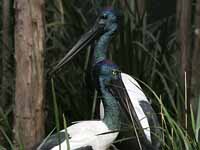
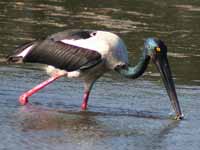

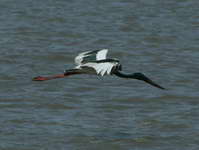
Stork,_Saddle-billed Ephippiorhynchus senegalensis
Description: Iridescent black head, neck, back, wings, tail; white rest of plumage; massive bill with yellow frontal shield – black band – red band; black legs with pink knees. Female: golden eyes. Male: brown eyes, Large stork: height 145 – 150 cm (4 ft 9 in – 4 ft 11 in), length 142 cm (4 ft 8 in), wingspan 2.4 – 2.7 m (7 ft 10 in – 8 ft 10 in), weight 5 – 7 kg (11 – 17 lb).
Identification: The saddle-billed stork is easy to identify because of its bill.
Range: sub-Saharan Africa.
Habitat and Behavior: Prefers reshwater aquatic areas. Builds nests in trees. Not colonial breeder. Eggs white.
Conservtion Status: Least concern, but population probably declining.
Image by: 1, 3) Arno Meintjes 2) Steve Garvie 4) Charlie Westerinen - Zimbabwe 5) Dick Daniels - Tanzania Identification: The saddle-billed stork is easy to identify because of its bill.
Range: sub-Saharan Africa.
Habitat and Behavior: Prefers reshwater aquatic areas. Builds nests in trees. Not colonial breeder. Eggs white.
Conservtion Status: Least concern, but population probably declining.
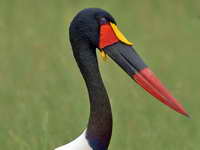
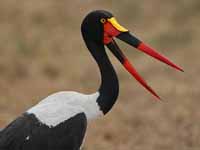
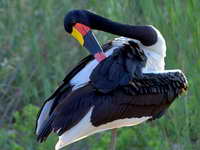
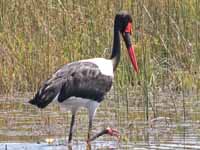
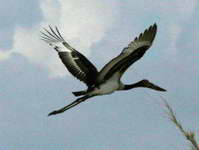
Genus Jabiru - 1 species
Jabiru Jabiru mycteria
Description: Mainly white plumage; bare and black head, upper neck; featherless red stretchable pouch at base of neck. Length 120–140 cm (47–55 in), wingspan 2.3–2.8 m (7.5–9.2 ft), weight 4.3–9 kg (9.5–19.8 lb). Male 25% larger than female; greatest size differential in stork family.
Identification: The only storks in the Americas are: jabiru, maguari stork, wood stork. They are easily differentiated.
Range: Mexico to Argentina, except west of the Andes; occasionally southern US.
Habitat and Behavior: Favors areas near rivers and ponds. Often forages in flocks. Eats mainly fish, amphibians, mollusks; also reptiles, eggs, carrion, and many other readily available prey. Builds stick plus mud nests in tall trees. Nest used more than one year, growing larger with subsequent use. Not colonial breeder.
Conservtion Status: Least concern.
Image by: 1, 2) láudio Timm - Brazil 3) David Schenfeld - Brazil 4) Allan Hopkins - GuyanaIdentification: The only storks in the Americas are: jabiru, maguari stork, wood stork. They are easily differentiated.
Range: Mexico to Argentina, except west of the Andes; occasionally southern US.
Habitat and Behavior: Favors areas near rivers and ponds. Often forages in flocks. Eats mainly fish, amphibians, mollusks; also reptiles, eggs, carrion, and many other readily available prey. Builds stick plus mud nests in tall trees. Nest used more than one year, growing larger with subsequent use. Not colonial breeder.
Conservtion Status: Least concern.
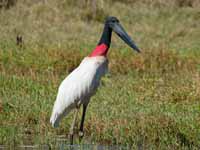

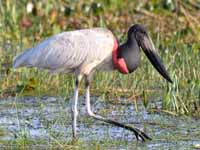

Genus Leptoptilos
Unlike most storks, the three Leptoptilos species fly with the neck retracted like a heron. They all have black upperparts, wings; white underparts; huge bills. They eat carrion, frogs, insects, young birds, lizards, rodents. All are colonial breeders and build stick nests in trees.
Adjunct, Greater Leptoptilos dubius
Description: Grey upperparts with some white on mantle; massive wedge-shaped pale grey bill; bare light grey crown; yellow to red neck; distinctive neck pouch (bright orange in breeding season); white underparts. Height 145–150 cm (4 ft 9 in–4 ft 11 in), length average 136 cm (4 ft 6 in), wingspan average 250 cm (8 ft 2 in).
Identification: The lesser adjutant and greater adjutant are relatively similar. “Lesser” has all dark upperparts; “greater” has some white on mantle. Only “greater” has throat pouch.
Range: southern Asia.
Habitat and Behavior: Prefers shallow freshwater locals, garbage dumps; often gathers with vultures. Mainly a scavenger; also eats fish, birds; basically any prey it can swallow. Nests high in trees. Not colonial breeder.
Conservtion Status: Endangered.
Image by: 1) Manvendra Bhangui 2, 3) Yathin 4) PandiyanIdentification: The lesser adjutant and greater adjutant are relatively similar. “Lesser” has all dark upperparts; “greater” has some white on mantle. Only “greater” has throat pouch.
Range: southern Asia.
Habitat and Behavior: Prefers shallow freshwater locals, garbage dumps; often gathers with vultures. Mainly a scavenger; also eats fish, birds; basically any prey it can swallow. Nests high in trees. Not colonial breeder.
Conservtion Status: Endangered.
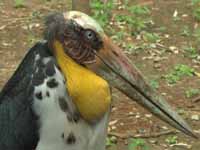
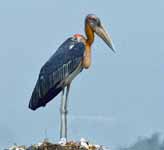


Adjunct, Lesser Leptoptilos javanicus
Description: Dark grey upperparts; wedge-shaped pale grey bill; bare light grey crown; white underparts. Breeding: orange neck; reddish face. Length 87–93 cm (34–37 in), height 110–120 cm (43–47 in), weight from 4 to 5.71 kg (8.8 to 12.6 lb).
Identification: The lesser adjutant and greater adjutant are relatively similar. “Lesser” has all dark upperparts; “greater” has some white on mantle. Only “greater” has throat pouch.
Range: India, Southeast Asia, Malaysia, Indonesia, Philippines.
Habitat and Behavior: Prefers freshwater and coastal wetlands, rivers, lakes. Searches for prey while walking. Eats mainly fish, frogs, reptiles, mollusks, rodents, small mammals; rarely carrion. Nests colonially in trees.
Conservtion Status: Vulnerable.
Image by: 1, 5) Lip Kee - India 2) Sandy Cole - Central Zoo of Nepal
3) Jason Thompson - Thailand 4) Steve GarvieIdentification: The lesser adjutant and greater adjutant are relatively similar. “Lesser” has all dark upperparts; “greater” has some white on mantle. Only “greater” has throat pouch.
Range: India, Southeast Asia, Malaysia, Indonesia, Philippines.
Habitat and Behavior: Prefers freshwater and coastal wetlands, rivers, lakes. Searches for prey while walking. Eats mainly fish, frogs, reptiles, mollusks, rodents, small mammals; rarely carrion. Nests colonially in trees.
Conservtion Status: Vulnerable.
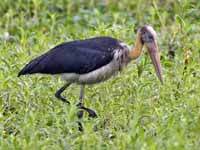


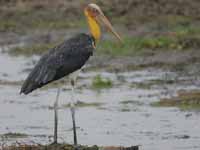
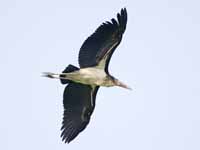
Stork,_Marabou Leptoptilos crumeniferus
Description: Black upperparts; white underparts; bare head, neck; pink throat sack; huge bill. Length 120 to 130 cm (47 to 51 in), height up to 152 cm (5 ft), wingspan 225–287 cm (7–9 ft), weight 4.5–8 kg (9.9–17.6 lb).
Identification: Unmistakable due to its massive bill and overall appearance.
Range: sub-Saharan Africa.
Habitat and Behavior: Comfortable in wet or dry habitats. Eats mainly carrion, garbage; thus evolved bare head like vultures. When raising young the adult eats more typical stork food such as fish, amphibians. Gregarious and a colonial breeder. Nests usually in trees; also cliffs. Needs made of sticks; lined with twigs, greenery.
Conservtion Status: Least concern.
Image by: 1) Arno Meintjes 2, 4, 5, 6) Dick Daniels - Tanzania 3) Dick - Tanzania 7, 8) Dick - KenyaIdentification: Unmistakable due to its massive bill and overall appearance.
Range: sub-Saharan Africa.
Habitat and Behavior: Comfortable in wet or dry habitats. Eats mainly carrion, garbage; thus evolved bare head like vultures. When raising young the adult eats more typical stork food such as fish, amphibians. Gregarious and a colonial breeder. Nests usually in trees; also cliffs. Needs made of sticks; lined with twigs, greenery.
Conservtion Status: Least concern.

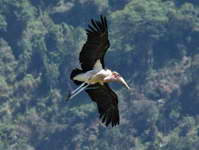

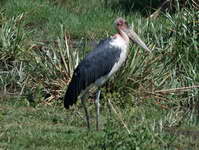
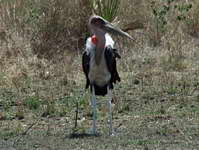
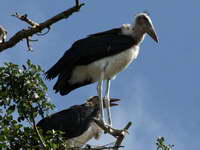


Genus Mycteria
These mainly white storks have similar bill structure. All sweep their half-open bill from side to side in water as they wade. When they detect prey they instinctively snap their jaws shut. They are colonial breeders and build their nests in trees.
At times these some of these storks have been considered to be part of the ibis family. DNA evidence now makes it clear that they areall storks..
Stork,_Milky Mycteria cinerea
Description: Mainly white plumage (creamy yellow breeding season); naked red face; greenish-black tail, flight feathers; pinkish yellow bill; dark eyes; pinkish legs. Height 91–97 cm (36-38 in).
Identification: The milky stork and painted storks are similar. “Painted” has more black plumage than “milky”.
Range: Mainly Southeast Asia, Malaysia.
Habitat and Behavior: Found in lowland coastal area. Eats mainly fish, shrimp. May hunt by slowly walking with bill in water; by disturbing the water with one foot; or in groups when prey is prevalent. Colonial breeding grounds located in mangroves. Nests located in trees. Conservtion Status: Least concern. Species
Image by: 1) Lip Kee Yap - Singapore 2) Aiza Zainol 3) DChai21 4) Sergey Pisarevskiy - SinaporeIdentification: The milky stork and painted storks are similar. “Painted” has more black plumage than “milky”.
Range: Mainly Southeast Asia, Malaysia.
Habitat and Behavior: Found in lowland coastal area. Eats mainly fish, shrimp. May hunt by slowly walking with bill in water; by disturbing the water with one foot; or in groups when prey is prevalent. Colonial breeding grounds located in mangroves. Nests located in trees. Conservtion Status: Least concern. Species
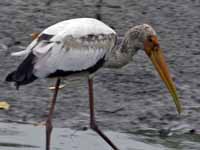
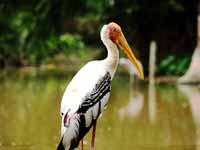
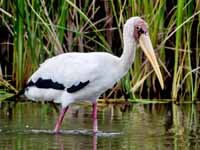
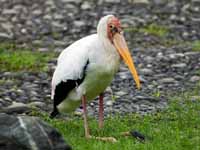
Stork,_Painted Mycteria leucocephala
Description: Mainly white plumage; black breast band with white scaly markings; bare orange or reddish face; yellow bill.; black tail. Medium sized stork: height 93–102 cm (36.5–40 in) , wingspan 150–160 cm (59–63 in), weight 2–3.5 kg (4.4–7.7 lb).
Identification: Painted stork has more black plumage than similar milky stork.
Range: Tropical areas Asia – India and Southeast Asia
Habitat and Behavior: Prefers shallow aquatic areas. Eats fish, amphibians, crustaceans, insects. Catch prey by moving head side to side in water to sense prey, then quickly close bills. Nests colonially in trees.
Conservtion Status: Near threatened.
Image by: 1) mdemon - Mysore, Karnatalso, India 2) Raul654 -
Disney's Animal Kingdom 3) Bhardwaj Shanthanu - Kachchh, Gujarat, INIdentification: Painted stork has more black plumage than similar milky stork.
Range: Tropical areas Asia – India and Southeast Asia
Habitat and Behavior: Prefers shallow aquatic areas. Eats fish, amphibians, crustaceans, insects. Catch prey by moving head side to side in water to sense prey, then quickly close bills. Nests colonially in trees.
Conservtion Status: Near threatened.
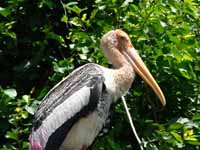
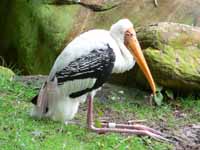
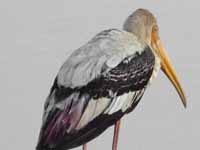
Stork,_Wood Mycteria americana
Description: Mainly all white plumage; blackish-grey legs; pink feet. In flight, the trailing edge of the wings is black. Brown bald head; dusky-yellow. thick down-curved bill. Height 83 to 115 cm (33–45 in), wingspan of 140 to 180 cm (55–71 in), average weight of 2.5 kg (5.5 lb).
Identification: The only storks in the Americas are: jabiru, maguari stork, wood stork. They are easily differentiated.
Range: The Americas (mainly tropical and subtropical).
Habitat and Behavior: Lives in freshwater or coastal wetlands. Eats fish, insects, crabs, frogs. Nests built in trees; made from sticks and vegetation. Colonial breeder. Seasonal declining water levels initiate breeding.
Conservtion Status: Least concern.
Image by: 1, 2) Dick Daniels - the town of Sunset Beach, North Carolina 3, 4)
Dick - Sunset Beach
5) Dick - Jacksonville, Florida 6) Dick - Everglades National Park, Florida Identification: The only storks in the Americas are: jabiru, maguari stork, wood stork. They are easily differentiated.
Range: The Americas (mainly tropical and subtropical).
Habitat and Behavior: Lives in freshwater or coastal wetlands. Eats fish, insects, crabs, frogs. Nests built in trees; made from sticks and vegetation. Colonial breeder. Seasonal declining water levels initiate breeding.
Conservtion Status: Least concern.
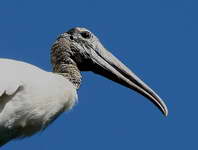

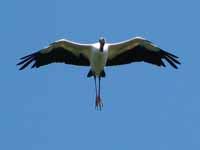

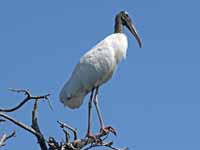

Stork,_Yellow-billed Mycteria ibis
Description: Mainly pinkish-white plumage; orange face; deep yellow bill; black wings, tail. Juvenile has greyish-brown plumage, bill; dull orange face; brownish legs. Height 90–105 cm (35–41 in). Juvenile: greyish-brown plumage, bill; dull orange face; brownish legs.
Identification: The painted storks has more black plumage than the similar milky stork.
Range: sub-Saharan Africa, Madagascar.
Habitat and Behavior: Prefers wetlands, shallow lakes and mudflats; usually avoids heavily forested regions. Eats crustaceans, worms, aquatic insects, frogs. Colonial breeders; engages in bill clattering while nesting.
Conservtion Status: Least concern.
Image by: 1, 7) Dick Daniels - Kenya 2, 3) Dick - the Jacksonville Zoo - Florida 4) Dick - San Diego Zoo 5) Dick - Tanzania 6) Nik_Borrow - Uganda S. Shankar - KenyaIdentification: The painted storks has more black plumage than the similar milky stork.
Range: sub-Saharan Africa, Madagascar.
Habitat and Behavior: Prefers wetlands, shallow lakes and mudflats; usually avoids heavily forested regions. Eats crustaceans, worms, aquatic insects, frogs. Colonial breeders; engages in bill clattering while nesting.
Conservtion Status: Least concern.
1) Juvenile 3) Storks kneel with their feet forward

